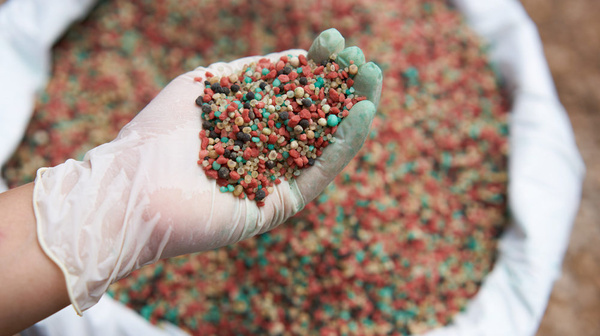
Fertilizing: What, How, and When
Fertilizing is one way to care for your lawn. It supplements the nutrients your soil provides to create a perfectly balanced diet for your turfgrass. Assess what nutrition your lawn is currently getting and choose an appropriate fertilizer accordingly.
In the hot, wet conditions of Florida summers, turfgrass grows like crazy. But warmth and water aren’t all grass needs to thrive. Another factor is the proper balance of nutrients provided by the soil.
What happens when soil is nutrient-deficient? Turfgrass suffers. This is where fertilizer can make the difference between an unhealthy, yellowed lawn and a vibrant, green one.
Fertilization Food Pyramid
Think back to middle school, and you may remember the good ol’ food pyramid, which visually presents food groups in their ideal consumption proportions. Similarly, plants do best when the fertilizer they receive has the correct ratio of three primary “food groups”: nitrogen, phosphorus, and potassium.
Look on a fertilizer label and you’ll find three bold numbers that correspond to the above nutrients. A label of 12-3-10 on a 100lb bag means that there are 12lbs of nitrogen (12%), 3lbs of phosphorus (3%), 10lbs of potassium (10%), and 75 remaining pounds of other fillers.
- A few rules of thumb when deciding on a fertilizer:
- Many Florida soils naturally contain high amounts of phosphorous, so you may not need to add much (or any). On your selected fertilizer, the middle number representing phosphorus should usually be as low as possible, even 0.
- The first and second numbers should be at least 4:1.
- The first and third numbers should be equal or 2:1.
These guidelines are the equivalent of “Fertilizing for Dummies.” They’re a good start and will serve you well overall, but they don’t account for the nutritional needs of all different plants, like palms. Know what plants you’re fertilizing and research their specific requirements to ensure you’re helping and not hurting.
Other Nutritional Considerations
To determine nutrient levels on your property, conduct a simple soil test. In addition to the three primary nutrients, results will give you information about other nutrients and the soil’s pH levels.
Reclaimed water sometimes contains nitrogen and phosphorous. Your utilities provider can provide that data. Take the soil test and nutrient presence in your water into consideration when choosing the right fertilizer.
Fertilizing in June
It’s good practice to fertilize in the spring, but if you forgot, it’s not too late to fertilize in June. A light application should catch you up just fine. If you did apply earlier this year, you might be noticing light green or yellow hues in your turf. This is normal and occurs as the grass gradually absorbs the spring fertilizer nutrients.
Here’s a pro tip—apply an iron-only product instead of a fertilizer. Liquid versions will be combined with water then spread over 1,000 sq. ft. of grass. Follow the directions on granular forms and apply with a spreader.
Fertilize in June if you haven’t yet this year, or use iron to boost color as nutrients from the last application are used.
One Last Note
Look up fertilizer ordinances and blackout periods in your county. For example, Volusia County prohibits applying fertilizer containing nitrogen or phosphorous between June 1 and September 30 every year. Depending on your location and violation, penalties could be $500 or more, increasing with subsequent offenses.